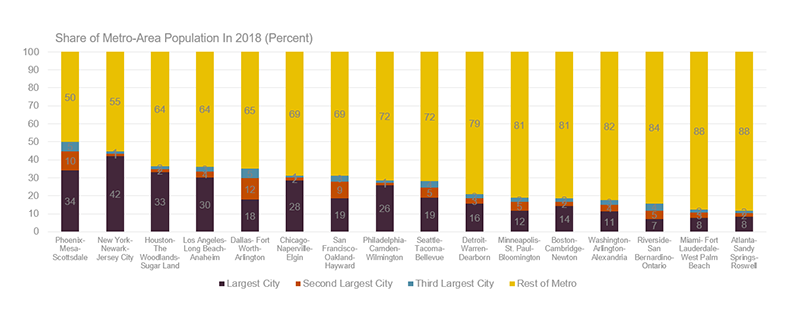Big Cities Are Taking on Housing Affordability, but Even the Largest Will Need Help
The nation’s largest cities are at the forefront of the battle against high housing costs. In efforts described in our latest State of the Nation’s Housing report and in previous blogs, several big cities have come forward to revise zoning and land use regulations to open up land and allow higher densities of housing development. Some have also made permitting procedures faster or less cumbersome, others have reduced requirements such as those for allocated parking to lower development costs, and a few have legalized less costly housing options such as accessory dwelling units. Many have also dedicated local funds to build and preserve affordable housing.
But how far can these big-city actions go to alleviate large-scale, regionwide challenges of high housing costs? A quick look at the Census Bureau’s latest population estimates suggests that cities can only go so far in solving affordability issues because even the largest cities are home to just a fraction of their metro area populations.
As shown in Figure 1, cities in the US make up just a small portion of the population within their overall metropolitan areas. Some cities make up a surprisingly low share. The cities of Miami and Atlanta, for example, are each home to just 8 percent of the populations in their respective metro areas. Washington, DC, despite its relatively high population density, is also home to just 11 percent of its metro area population. The city of Boston, which is part of a particularly fractured metropolitan area that includes dozens of small New England cities and towns, is home to just 14 percent of the population in the Boston-Cambridge-Newton metropolitan area.
Figure 1: Even the Largest Cities Make Up Just a Small Portion of Their Metro Area Populations
Source: JCHS tabulations of US Census Bureau, 2018 Population Estimates.
Even the combined populations of the three largest principal cities in each metro – those in the official metro area name – account for just 27 percent of metro area populations, on average, among the nation’s 16 largest metros included in figure 1. And populations in the second- and third-largest cities in most metros drop off quickly. New York City, for example, is home to fully 42 percent of the metro area population, but the second largest city in the metro area, Newark, is home to just 1 percent. Los Angeles is home to 30 percent of residents, but just 4 percent of the LA metro residents live in the second largest city in the metro, Long Beach.
With 73 percent of the population in the nation’s top 16 largest metro areas living outside the three largest cities, efforts in smaller suburban cities and towns will be just as necessary to solve regional housing affordability challenges, even if they do not garner the headlines that big-city efforts may get. While many such places are indeed taking steps to reduce barriers to development on their own, most are not, which underscores the need for additional involvement from state and federal governments to spur the level of change needed at the local level to address regional housing problems.
Several innovative state and local programs will be discussed at Housing + Innovation, a half-day symposium taking place at Harvard on Friday, November 15th.


